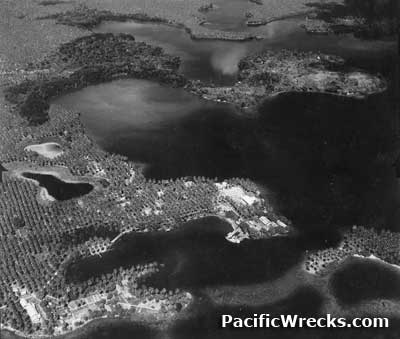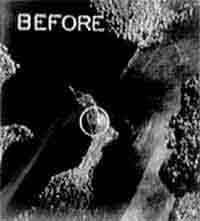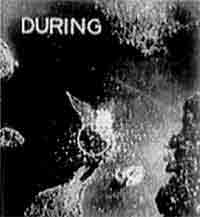|
|
|
|
| Missing In Action (MIA) | Prisoners Of War (POW) | Unexploded Ordnance (UXO) |
| Chronology | Locations | Aircraft | Ships | Submit Info | How You Can Help | Donate |
|
 AWM c1915  USAAF 1943   38th BG c1943   5th AF Dec 27, 1943  AWM 1944  Justin Taylan 2000 |
Location Lat 5° 4' 60S Long145° 48' 0E Alexishafen is located on the north coast of New Guinea. Also spelled Alexishaven. Borders Sek Harbor (Alexishafen Harbor) to the east with Megas Island, Admosin Island and Sek Island. To the west was Alexishafen Airfield (Alexishafen I) and to the northwest is Danip and Danip Airfield (Alexishafen II). Connected via the North Coast Road southward to Madang. To the north is Bostrem Bay. Prewar and during the Pacific War located in Madang District in the Territory of New Guinea. Today located in Madang Province in Papua New Guinea (PNG). Prewar During the German administration of New Guinea, the Catholic chuch estabilshed the Alexishafen Catholic Mission at Alexishafen. Wartime History On December 23, 1942 during the night, Japanese Army soldiers in barges from Madang landed at Alexishafen and occupied the area without opposition. Initially, the Japanese Army officer assigned to the assured the Catholic missionaries were unharmed and allowed to go about their business, but were guarded by the Japanese. The Japanese Army developed the Alexishafen area into a base and airfield area. The Japanese occupied and explanded Alexishafen Airfield (Danip, Alexishafen II) and built a larger runway to the south for bombers known as Alexishafen Airfield (Alexishafen I). The Alexishafen area was defended by anti-aircraft gun batteries. During late 1942 until April 1944, Allied aircraft bombed and strafed the area, destroying the Alexishafen Catholic Mission Cathedral and netralized both airfields. During the middle of April 1944, as Australian forces neared, the Japanese mined and set booby traps along the North Coast Road then withdrew from the area. American missions against Alexishafen December 18, 1942–April 15, 1944 On April 26, 1944 the Australian Army 5th Division, 30th Battalion liberated Alexishafen, without resistance, while the 35th Battalion continuing to advance northward along the coast. Many supply dumps and abandoned equipment were captured in the area. Afterwards, the Allies used Alexishafen and Sek Harbor as a base area to support operations. Today The Catholic church is still the primary landowner in the Alexishafen area. Postwar, many areas were returned to grazing areas for cattle and agriculture, protecting the war relics from scrapping. Today, squatters live on the outskirts. Alexishafen Catholic Mission (St. Fidelis College) Prewar Catholic Mission. During 1942, led by Bishop Wolfe with seventy missionaries including sisters who chose not to evacuate when the threat of Japanese invasion loomed. In early January 1943 occupied by the Japanese. During the Pacific War, the mission was totally destroyed by U.S. air raids and the retreating Japanese. St. Fidelis Seminary (St. Fidelis College) Located to the northwest of Alexishafen on the north coast of New Guinea bordering Sek Harbor (Alexishafen Harbor) and Bostrem Bay. On December 18, 1942, during the night, occupied by the Imperial Japanese Army (IJA) Occupied by the Japanese that emplaced a battery of four 75mm Type 88 Anti-Aircraft guns emplaced at the point overlooking Sek Harbor. Known as St. Fidelis College (Saint Fidelis). Many relics remain on the mission properly undisturbed. Unlike other relics that have since been scrapped or removed, the mission land is protected and is why they are left intact. The mission's sign is made from a large Japanese propeller, probably from a bomber from Alexishafen. Also, the stations of the cross are painted onto large ship screws, probably from wrecks or abandoned equipment in the harbor area. Danip Airfield (Alexishafen II, Strip No 1) Built prewar as Alexishafen Airfield used by the Catholic Mission, expanded by the Japanese disused today Alexishafen Airfield (Alexishafen I, Strip No. 2) Japanese built airfield, second strip Ki-61 Tony Crash site, majority scrapped, main spar and shattered remains only M3 Medium Tank (Lower Half) Displayed at road junction near Catholic mission. Nearby is the mount for a 75mm Anti-Aircraft Gun (mount only). B-25D "Jelly Belly 2nd" 41-30516 Pilot Thompson crashed September 9, 1943 crew killed in crash References Madang (2006) by James Sinclair page 147 "Maria Kramer in Alexishafen (where she still lives today), she recalled that one morning she rose as usual to prepare for 6 am Mass, and looked outside and the whole station was just occupied by Japanese. They came in overnight and in the morning when we all got up, there they were. The whole place just covered in Japs. They came in barges, no trouble, no fight, nothing." Contribute
Information Last Updated
|
Map 1943 Map Sept 28, 1943 Map Jan 16, 1944 Map Fallingrain Map Mapcarta Photo Archive |
| Discussion Forum | Daily Updates | Reviews | Museums | Interviews & Oral Histories |
|